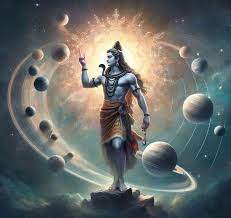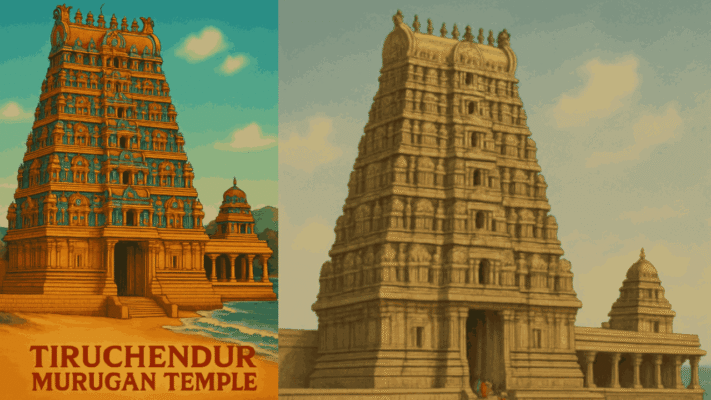Tiruchendur Murugan Temple, located in the picturesque coastal town of Tiruchendur in Tamil Nadu’s Thoothukudi district, is a divine sanctuary that holds a unique place among the six sacred abodes (Arupadai Veedu) of Lord Murugan. This ancient temple, celebrated for its spiritual significance, architectural grandeur, and rich cultural heritage, draws millions of devotees annually who come seeking blessings of valor, wisdom, and divine protection.
Introduction to Tiruchendur
Nestled on the shores of the Bay of Bengal, Tiruchendur stands out as the only major Murugan temple situated on the sea coast. Unlike the other five abodes which reside on hills or mountainous regions, Tiruchendur’s seaside location symbolizes Lord Murugan’s epic battle victory over the demon king Surapadman, a pivotal event in Tamil mythology that underscores the triumph of good over evil.
The temple is famed not only for its religious importance but also for its stunning Dravidian architectural style, grand festivals, and the unique rituals performed here. Its legacy dates back over two millennia, with layers of history shaped by various Tamil dynasties, devout saints, and the faith of millions.
Historical and Mythological Background
The Legend of Lord Murugan and Surapadman
According to Hindu mythology and the Skanda Purana, Surapadman was a powerful demon who conquered the three worlds—heaven, earth, and underworld—posing a grave threat to the celestial beings (devas). After failing to be subdued by the gods, Lord Shiva’s son, Murugan, was invoked to vanquish Surapadman and restore cosmic order.
The mighty battle took place near the shores of Tiruchendur, where Murugan, armed with his divine spear (Vel), defeated Surapadman in a fierce combat. According to legend, Murugan split the demon into two halves; these halves were transformed into his sacred peacock mount and the rooster emblem, both enduring symbols of the deity.
Establishment of the Temple
Following his victory, Lord Murugan sought to express gratitude to his father Shiva. He summoned Mayan, the celestial architect, who crafted the temple at Tiruchendur as a symbol of triumph and devotion. This divine origin story makes the temple not only a place of worship but also a spiritual landmark commemorating courage, righteousness, and divine intervention.
Historical Occupations and Renovations
The temple has witnessed many historical events, including the Dutch East India Company’s occupation between 1646 and 1648 during their conflict with the Portuguese. The Dutch attempted to remove the temple idols—leading to a legendary tale of the idols being lost at sea and miraculously recovered by a devoted fisherman, Vadamaliyappa Pillai. This episode reinforces the temple’s mystical aura and the faith of its followers.
Over the centuries, the temple has been remodeled and expanded by Chera, Chola, and Pandya rulers. In modern times, extensive renovation projects have been undertaken to preserve its heritage and accommodate growing numbers of worshippers.
Architectural Marvels of Tiruchendur Temple
Dravidian Style on the Coastline
Tiruchendur Murugan Temple is an exquisite example of traditional Dravidian temple architecture, imbued with coastal influences. The temple’s most striking feature is its towering nine-tiered gopuram (temple tower), which rises majestically to 157 feet, visible from miles away and serving as a spiritual beacon for devotees and travelers alike.
Unique Structural Elements
- Sanctum Sanctorum: The inner sanctum (garbhagriha) houses the main deity, Murugan, depicted as a saintly child carved from granite. The sanctum is carved into a cave-like structure, unique for a coastal temple.
- Avast Mandapam: The grand, pillared hall welcomes visitors with 124 intricately carved pillars showcasing Tamil craftsmanship.
- Sacred Wells: The temple complex includes Nali Kinaru, a freshwater well located about 100 meters to the south, where devotees perform ritual purification after bathing in the sea.
- Sandstone Construction: Unlike many granite-based South Indian temples, this structure extensively uses sandstone, harmonizing with its beach environment and adding to its distinct appearance.
Temple Layout and Dimensions
The temple spans approximately 299 feet from north to south and 213 feet east to west, covering a large area to accommodate thousands of pilgrims during festivals and daily worship.
Religious Significance and Rituals
Deity and Divine Representations
Lord Murugan at Tiruchendur is revered as the victorious warrior and commander of the celestial forces. He is worshipped here in his youthful, compassionate form, embodying courage, valor, and divine protection.
The presence of various avatars of Shiva and Vishnu within the temple boundary signifies theological inclusiveness, making Tiruchendur a holistic spiritual center.
Daily Worship and Rituals
Devotional activities are conducted six times daily, including:
- Ushat Kalam (Morning): Early morning prayers invoking fresh blessings.
- Kalasanthi (Mid-morning): Intense devotional worship with abhishekam (ritual bathing of the deity) using milk, water, and sandalwood paste.
- Uchikalam (Noon): Midday worship and offerings.
- Sayarakshai (Evening): Evening arati accompanied by nadaswaram music.
- Irandam Kalam (Night): Second round of evening prayers.
- Arthajama Pooja (Late Night): Last ritual before temple closes.
Special offerings include tonsuring (shaving of heads), carrying kavadi (ornate structures symbolizing penance), and presenting vels (sacred spears) as acts of devotion and gratitude.
Major Festivals at Tiruchendur
Skanda Sashti Festival
The crown jewel of Tiruchendur’s festival calendar is Skanda Sashti, celebrated during the Tamil month of Aippasi (October-November). This six-day event commemorates the epic battle between Lord Murugan and demon Surapadman:
- Devotees observe fasting and spiritual discipline.
- Daily recitation of hymns like Kanda Sashti Kavasam fills the air.
- The climactic Soorasamharam—a dramatic enactment of the divine victory—is performed on the sixth day, attracting more than half a million participants.
- The seventh day marks Tirukkalyanam (divine wedding), celebrating Murugan’s marriage to Deivayanai in grand ceremonies.
Masi and Avani Brahmotsavams
Held biannually in the Tamil months of Masi (February-March) and Avani (August-September), these festivals are twelve-day celebrations featuring:
- Grand temple car (ratha) processions with three massive temple chariots.
- Teppam or float festivals in which deities are taken on elaborately decorated boats.
- Floral decorations with vibrant Pachai Sathi (green adornments).
- Massive participation from rural and urban devotees.
Vaikasi Visakam
Celebrated in May-June, Vaikasi Visakam marks the birthday of Lord Murugan. Devotees flood the temple for ten days with colorful processions, traditional dances, and nightly celebrations, showcasing Tamil cultural and religious fervor.
Panguni Uthiram
This festival celebrates divine marriages in Hindu mythology, particularly Murugan’s wedding to Deivayanai. It features special poojas, decorations, and processions vital to the temple’s ritual calendar.
Pilgrimage and Devotional Practices
Ritual Cleansing
A key spiritual practice for pilgrims is bathing in the Bay of Bengal followed by ritual purification at Nali Kinaru well. This symbolizes shedding worldly impurities before entering the sanctum.
Vows and Offerings
Devotees undertake personal vows such as carrying kavadi, performing tonsure, offering abhisheka, and donating sacred spears, fulfilling prayers related to health, prosperity, and protection.
Dress Code and Temple Etiquette
Men typically enter the sanctum without upper garments, donning traditional dhotis. Traditional attire is recommended for women. Fountain of devotion is maintained with strict discipline, reverence, and cleanliness within temple premises.
Recent Renovations and Modern Developments
The temple is undergoing a massive renovation to enhance facilities for the growing number of pilgrims. Projects worth over Rs 300 crore include:
- Construction of a drinking water sump, administration blocks, and queue management systems.
- Building of 450 toilets, annadhanam (free food distribution) mandapams, and shopping complexes.
- New approach roads and expanded parking facilities to ease congestion.
- Conservation efforts ensuring no trees are harmed during renovation.
These efforts aim to preserve the temple’s sanctity while providing modern conveniences, making the pilgrimage comfortable and spiritually fulfilling.
Cultural Impact and Literary Connections
Tamil Literary References
Tiruchendur has been extolled in classical Tamil texts such as Thirumurugatrupadai by Nakkeerar and devotional hymns by saint-poet Arunagirinathar, whose Thiruppugazh compositions remain central to Murugan worship.
Devotional Music and Dance
The temple hosts regular cultural performances, including Carnatic music concerts and Bharatanatyam dance recitals, integrating spiritual devotion with Tamil art forms.
Social and Religious Hub
The temple remains a focal point for Tamil identity, spirituality, and community cohesion, hosting millions during festival seasons and daily worship.
How to Reach Tiruchendur?
- By Air: Nearest airports are Tuticorin Airport (40 km) and Madurai Airport (190 km).
- By Train: Tiruchendur Railway Station connects major cities and towns.
- By Road: Well-connected by buses and taxis from Madurai, Thoothukudi, Tirunelveli, and surrounding regions.
Ample accommodation options are available nearby, including pilgrim rest houses and hotels, ensuring convenience for visitors.
Conclusion
The Tiruchendur Murugan Temple stands as a radiant testament to Tamil devotion, architectural brilliance, and spiritual legacy. Its unique coastal setting, profound mythological significance, vibrant festivals, and centuries-old traditions make it an irresistible pilgrimage destination.
Whether seeking divine blessings, cultural immersion, or spiritual awakening, visitors to Tiruchendur encounter a mesmerizing blend of faith, history, and art. As the waves of the Bay of Bengal wash the shores below the temple, they symbolize the eternal presence and grace of Lord Murugan—the victorious god of the seas, protector, and beloved deity of millions.
This sacred abode continues to inspire generations, reaffirming the timeless mantra of devotion: to conquer evil, nurture righteousness, and embrace divine love.

Krishna is an author and Co-founder of karungali.co.in. He is a lord siva devotee who have very good knowledge on devotional goods and prayer methods. In specific he is in to this devotional goods selling since 2019. His knowledge on karungali (ebony products) and using procedure helps several people.
